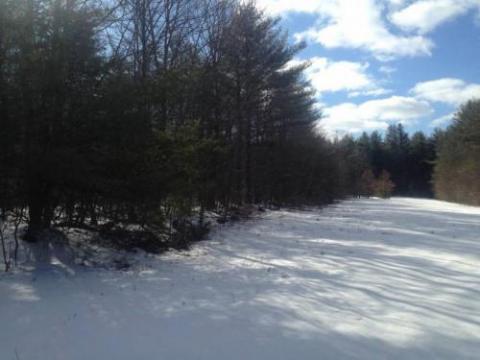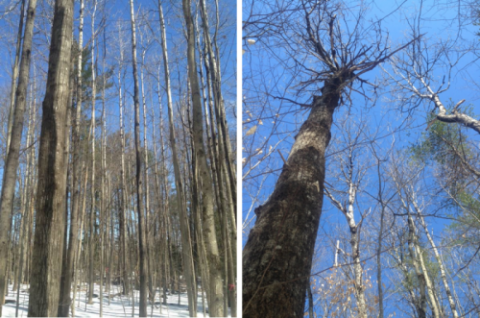Maintaining Traditions at Leonard Wildlife Management Area
As we walk through the woods we see a 10-15” diameter aspen here and there plus an occasional clump amidst what would otherwise be characterized as a pine-oak-maple stand with some beech, paper birch, and white ash. We see stone walls and tote roads dividing up these woods into clear sections or blocks. And as we approach a small old field, we see a couple of scattered apple trees along the edge that are way past their prime.
There are a couple of old foundations, and just to the west of the field is a patch of huge multi-stemmed bull pine. Put all of this together, and we see amazing potential!
I’m walking the 855-acre Leonard Wildlife Management Area in Webster with other staff from Fish and Game and our longtime partner, the NH Division of Forests and Lands (NHDFL). The northern section that we were walking through was purchased by NH Fish and Game in 1975 and has a long history of management. The stonewalls and foundations harken back to the days when this area was a farm. Shortly after Fish and Game purchased the property, biologist Harold “Flip” Nevers started managing it as a grouse and woodcock demonstration area. First, patch cuts were made to stimulate root suckering of the aspen to improve breeding cover. When an area containing aspen is clearcut, dormant buds on the roots sprout, often producing several thousand suckers per acre, which is just the type of cover that woodcock, grouse, and several young forest songbirds like chestnut-sided warbler look for. The aspen we see now are probably those that remain from the cuts in the 1980s. In addition to aspen cutting, apple trees were released, fertilized and pruned to provide food, and additional plantings were done.
Subsequent staff has maintained the old fields and further enhanced aspen cover with a combination of prescribed burning, mowing, and herbicide applications to control invasive exotic plants, some of which were planted in the 1970s. A 1993 timber harvest in surrounding areas, completed by NHDFL staff, released hard mast trees and established red oak regeneration.

This small, narrow field will be enlarged to provide suitable woodcock roosting and breeding grounds. Several other wildlife will also benefit. (Photo by Jim Oehler)
And now plans are underway to take this demonstration area to the next level. A portion of the bull pines adjacent to the southern field will be cut and stumped as part of an upcoming timber harvest to create a 5-acre field, free of overhead cover, and suitable for use as an evening roost for woodcock. The field will also provide suitable woodcock breeding grounds and be used as a foraging area for deer, turkey, and a variety of songbirds. Crab apples or other soft mast producing trees/shrubs may be planted by NHFG staff to provide an additional food source and to replace old apple trees that are no longer viable.
Surrounding the field will be eight cutting blocks, two of which will be clear cut every fifteen years, resulting in four entries over a 60 year period (i.e., a 60-year rotation). Rotations for pine-oak-maple can range from 80-120 years. However, given our objective of maintaining good aspen cover and aspen’s relatively short life span, 45-60 year rotations are generally the way to go. Blocks were laid out along stonewalls and old woods roads to get each as close to five acres as possible, which is the recommended size for woodcock.

Our first cut will focus on blocks with a heavy component of aspen (left). Plus groups of aspen will be cut elsewhere before it gets too old and dies out (right). (Photo by Jim Oehler)
Our first cut will focus on blocks with a heavy component of aspen (left). Plus groups of aspen will be cut elsewhere before it gets too old and dies out (right). (Photo by Jim Oehler)Our first entry, planned for the winter of 2017/18, will focus on those blocks with a heavy component of aspen. But if we wait for subsequent entries to hit the aspen in the other blocks, it may be too late - that aspen may have grown too old to produce root suckers or may simply die out. So, any aspen in those blocks will also be cut during this first entry to ensure it remains as part of the mix. Future entries into those blocks will help to spread the aspen until eventually, after one or two rotations, aspen will dominate each block, and we’ll have a diversity of woodland age classes, excellent grouse and woodcock habitat that will be sustained, and excellent young forest habitat for a variety of other wildlife from deer to yellow warblers and from moose to snowshoe hares.
- For more information on the Leonard WMA and for maps and directions on how to get there, visit: http://www.wildlife.state.nh.us/maps/wma/leonard.html
- To learn about how NHFG manages its properties, visit: http://www.wildlife.state.nh.us/habitat/improving.html
- For more information on young forest habitat, who uses it, and where and how to make it, visit: http://youngforest.org/


